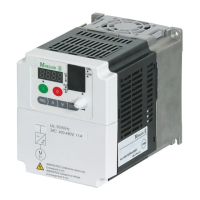Installation
09/01 AWB8230-1412GB
38
Connecting the control signal terminals
The following figure shows the arrangement of the individual
control signal terminals.
Function of the control signal terminals
Table 6: Meaning of the control signal terminals
Figure 32: Location of the control signal terminals
L54321P24
h O OI L FM CM2 12 11
ESD measures
Discharge yourself on an earthed surface before touching
the frequency inverter and its accessories.
This prevents damage to the devices through electrostatic
discharge.
No. Function Level Default setting Technical data, description
L Common reference
potential
0 V – Reference potential for the internal voltage sources
P24 and H
5 Digital input
HIGH = +12 to +27 V
LOW = 0 to +3 V
Reset PNP logic, configurable, R
i
=33kO
Reference potential: Terminal L
4 Digital input
FF2 (FF3) = fixed frequency 2
(3)
PNP logic, configurable, R
i
=5kO
Reference potential: Terminal L
3 Digital input
FF1 (FF3) = fixed frequency 1
(3)
2 Digital input
REV = anticlockwise rotation
1 Digital input
FWD = clockwise rotation
P24 Control voltage output
+24 V – Supply voltage for actuation of digital inputs 1 to 5.
Load carrying capacity: 30 mA
Reference potential: Terminal L
h Setpoint voltage output
+10 V – Supply voltage for external setpoint potentiometer.
Load carrying capacity: 10 mA
Reference potential: Terminal L
OAnalog input
0 to +10 V Frequency setpoint value
(0 to 50 Hz)
R
i
= 10 kO
Reference potential: Terminal L
OI Analog input
4 to 20 mA Frequency setpoint value
(0 to 50 Hz)
R
B
= 250 O
Output: Terminal L
L Common reference
potential
0V – Reference potential for the internal voltage source
P24 and H
FM Analog output
0 to +10 V Frequency actual value
(0 to 50 Hz)
Configurable, monitored DC voltage; 10 V corres-
ponds to set final frequency (50 Hz).
Accuracy: g5 % from final value
Load carrying capacity: 1 mA
Reference potential: Terminal L

